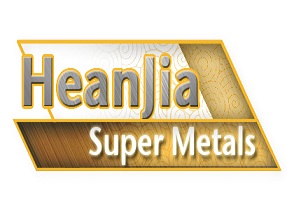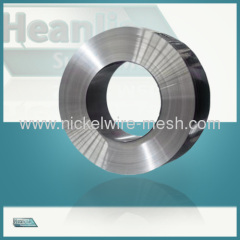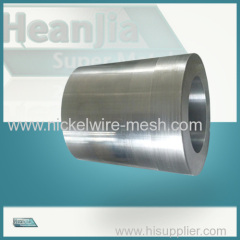
|
Heanjia Super-metals Co., Ltd.
|
Nickel Sheet Strip Plate Nickel 201 Sheet Strip Plate
| Payment Terms: | T/T,L/C,D/A,D/P,WU |
| Place of Origin: | Hebei, China (Mainland) |
|
|
|
| Add to My Favorites | |
| HiSupplier Escrow |
Product Detail
Nickel 201 strip has a lower carbon content to prevent embrittlement by inter-granular carbon at elevated temperature
Nickel 201 Sheet Strip Plate
Nickel 201 Sheet Strip Plate Description:
Nickel 201 Sheet Strip Plate Description:
Commercially pure wrought Nickel 201 with similar properties to Alloy 200 but with a lower carbon content to prevent embrittlement by inter-granular carbon at elevated temperatures.
Nickel 201 Sheet Strip Plate Chemical Composition
Chemical Requirements | |||||||
Ni | Mn | C | Si | Fe | Cu | S | |
Max | 0.35 | 0.02 | 0.35 | 0.40 | 0.25 | 0.01 | |
Min | 99.0 | ||||||
Nickel 201 Sheet Strip Plate Characteristics
1.Good resistance to corrosion in acids and alkalis and is most useful under reducing conditions.
2.Outstanding resistance to caustic alkalis up to and including the molten state.
3.In acid, alkaline and neutral salt solutions the material shows good resistance, but in oxidising salt solutions severe attack will occur.
4.Resistant to all dry gases at room temperature and in dry chlorine and hydrogen chloride may be used in temperatures up to 550C.
5.Resistance to mineral acids varies according to temperature and concentration and whether the solution is aerated or not. Corrosion resistance is better in de-aerated acid.
6.Virtually immune to inter granular attack above 315C, chlorates must be kept to a minimum.
Nickel 201 Sheet Strip Plate Applications
1.Manufacture and handling of sodium hydroxide, particularly at temperature above 300C.
2.Production of viscose rayon. Manufacture of soap.
3.Analine hydrochloride production and in the chlorination of aliphatic hydrocarbons such as benzene, methane and ethane.
4.Manufacture of vinyl chloride monomer.
5.Reactors and vessels in which fluorine is generated and reacted with hydrocarbons.
Physical Properties
Density | 8.9 g/cm cube |
Specific Heat | 440 J/kg K |
Electrical Resistivity | 8.5 micro ohms cm |
Curie Temperature | 358 C |
Melting Range | 1435-1445 C |
Thermal Expansion | (106K) 14.3 (20-300 C) |
Tensile Data
Mechanical Property Requirements | |||||
Ultimate Tensile | Yield Strength (0.2% OS) | Elong. | R/A | Hardness | |
Min | 50 KSi | 10 KSi | 40 | ||
Max | |||||
Min | 345 MPa | 70 MPa | |||
Max | |||||
Nickel 201 can be hot formed to almost any shape. The temperature range 1200°F to 2250°F is recommended and should be carefully abided as the proper temperature is the most important factor in achieving hot malleability. Full information of the forming process should be sought and understood before proceeding.
Nickel 201 can be cold formed by all conventional methods, but because nickel alloys have greater stiffness than stainless steels more power is required to perform the operations.
Nickel 201 is the low carbon version of Nickel 200. It is preferred to Nickel 200 for applications involving exposure to temperatures above 600°F. With low base hardness and lower work-hardening rate, it is particularly suited for cold forming.
High Temperature Mechanical Properties of Annealed Nickel 201 | ||||
Temp.°F | Tensile Strength, PSI | Yield Strength, PSI | Elongation,% | Reduction of Area, % |
Room | 58,500 | 15,000 | 50 | 73 |
200 | 56,100 | 15,400 | 45 | 74 |
400 | 54,000 | 14,800 | 44 | 72 |
600 | 52,500 | 15,300 | 42 | 72 |
800 | 41,200 | 13,500 | 58 | 80 |
1000 | 33,100 | 12,100 | 60 | 84 |
1200 | 22,200 | 10,200 | 74 | 90 |
Didn't find what you're looking for?
Post Buying Lead or contact
HiSupplier Customer Service Center
for help!
Related Search
Nickel Strip
Nickel Plate
Nickel Silver Strip
Sheet And Strip
Pure Nickel Plate
Nickel Alloy Sheet
More>>













